Solitary Bees
I became interested in solitary bees after watching a leaf-cutter bee sealing its nest in a hole in my house wall. It was fascinating seeing this bee neatly seal the entrance with a carefully cut piece of leaf, and also explained why some rose bushes in our garden had lots of holes in the leaves!
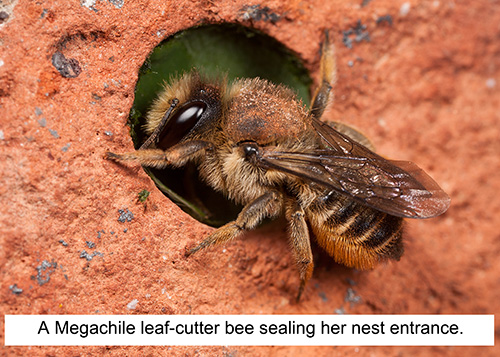 Most people know about honey bees and bumblebees, but little about solitary bees. We have nearly 30 types of bumblebee in the UK and one honeybee, but well over 200 types of solitary bee.
Most people know about honey bees and bumblebees, but little about solitary bees. We have nearly 30 types of bumblebee in the UK and one honeybee, but well over 200 types of solitary bee.
Honeybees and bumblebees are “social” insects in that a queen starts a nest and her female offspring (workers) keep it supplied with food. Solitary bees are different, as the female may make several nests; typically holes in the ground, in old walls or in wood, and will never see her offspring. Once you start looking, you realise that there’s lots of solitary bee activity going on all over the place. I decided in 2011 to record and photograph solitary bees in my garden and in the local churchyard and to learn more about their behaviour. I had the necessary photographic equipment to allow me to take really close-up images of the bees and maximise my chances of properly identifying them. Lots are very hard to identify properly from photographs though, some impossible.
 It did not take me long to find that the house wall was also providing accommodation for other types of bees. I had seen what I thought was a type of all-black bumblebee using holes in the mortar on the stone part of our house wall. These turned out to be female Hairy-Footed Flower Bees (Anthophora plumipes). There were also some mason bees; the Red Mason Bee (Osmia rufa) and the smaller Osmia leaiana using the walls.
It did not take me long to find that the house wall was also providing accommodation for other types of bees. I had seen what I thought was a type of all-black bumblebee using holes in the mortar on the stone part of our house wall. These turned out to be female Hairy-Footed Flower Bees (Anthophora plumipes). There were also some mason bees; the Red Mason Bee (Osmia rufa) and the smaller Osmia leaiana using the walls.
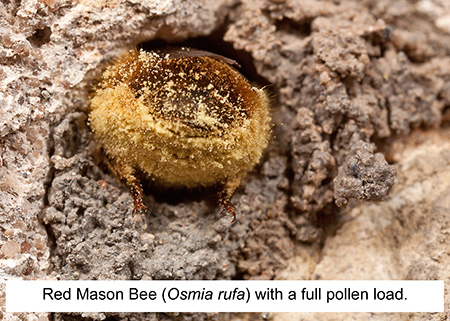 Once you start looking at these bees you realise that there are lots of differences from honeybees. Whereas for example, we see honeybees carrying pollen in special pollen “baskets” on their hind legs, some solitary bees have special hairs under their abdomens for this. This can be seen in the picture of the mason bee entering its nest. Many solitary bees though, have "pollen “baskets” on their hind legs, similar to honeybees.
Once you start looking at these bees you realise that there are lots of differences from honeybees. Whereas for example, we see honeybees carrying pollen in special pollen “baskets” on their hind legs, some solitary bees have special hairs under their abdomens for this. This can be seen in the picture of the mason bee entering its nest. Many solitary bees though, have "pollen “baskets” on their hind legs, similar to honeybees.
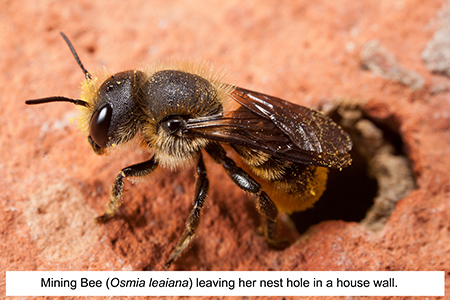 Solitary bees place little piles of pollen and nectar in their nest chambers and lay an egg on each pile. The nest tunnels are divided into individual cells each containing a single egg, together with a food ration. When the tunnel is complete, the entrance is sealed. The eggs hatch and the larvae eat the food left by the parent female. They then spin a cocoon and over-winter in the hole; emerging as adults at various times during the following spring and summer depending on the species and whether their favoured flower type is available. The lifecycle then starts once again. Other types of solitary bees make their nests in the ground, forming little volcano-like piles of soil as they excavate their burrows.
Solitary bees place little piles of pollen and nectar in their nest chambers and lay an egg on each pile. The nest tunnels are divided into individual cells each containing a single egg, together with a food ration. When the tunnel is complete, the entrance is sealed. The eggs hatch and the larvae eat the food left by the parent female. They then spin a cocoon and over-winter in the hole; emerging as adults at various times during the following spring and summer depending on the species and whether their favoured flower type is available. The lifecycle then starts once again. Other types of solitary bees make their nests in the ground, forming little volcano-like piles of soil as they excavate their burrows.
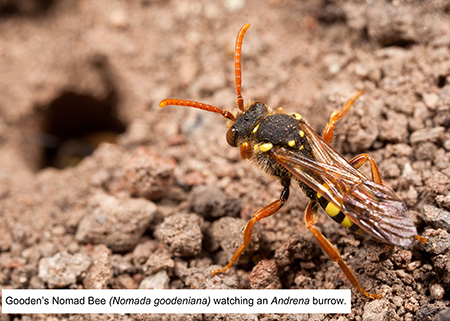 The lives of these bees may appear uncomplicated, but it’s not all that it seems. I was surprised when I first read that over a third of solitary bees were parasites of other bees. I had been watching varieties of some common Andrena mining bees and soon spotted some interlopers around their nest burrows. These were Nomada cuckoo bees, looking a bit like wasps. They are known as cleptoparasites because they ‘steal’ the nests of other bees. They wait until the “host” bee is away from the nest and then they lay their eggs inside. When the eggs hatch, the larvae eat the eggs already laid by the resident bee, and the food supply. Because they make no nests of their own, cuckoo bees have no mechanisms for collecting pollen. They do visit flowers though, to feed on nectar.
The lives of these bees may appear uncomplicated, but it’s not all that it seems. I was surprised when I first read that over a third of solitary bees were parasites of other bees. I had been watching varieties of some common Andrena mining bees and soon spotted some interlopers around their nest burrows. These were Nomada cuckoo bees, looking a bit like wasps. They are known as cleptoparasites because they ‘steal’ the nests of other bees. They wait until the “host” bee is away from the nest and then they lay their eggs inside. When the eggs hatch, the larvae eat the eggs already laid by the resident bee, and the food supply. Because they make no nests of their own, cuckoo bees have no mechanisms for collecting pollen. They do visit flowers though, to feed on nectar.
I became determined to photograph more of the solitary bees in my area and to get better at recognising the different types and species. Wherever you look, you find more varieties and begin to understand their interesting lifestyles. Some are extremely small and don’t conform to our expectations of what bees should look like. I found several variaties of tiny white-faced bees living in holes in grave stones an the churchyard and feeding on flowers there.
As they spend lots of time visiting flowers, solitary bees are important pollinators and should definitely be encouraged into the garden. There are lots of “bee hotels” available in garden centres and plenty of information around on making your own.
Encouraging solitary bees is also a child-friendly activity, because solitary bees rarely sting and even if they do, their sting is very weak. It looks like there’s increasing interest in encouraging garden wildlife these days. Lots of people feed their garden birds and have an understanding of the importance of insect-friendly planting and the need to maintain “wild” areas in their gardens where possible. Providing habitats for solitary bees is an important part of that process and for some, has become an absorbing hobby too!
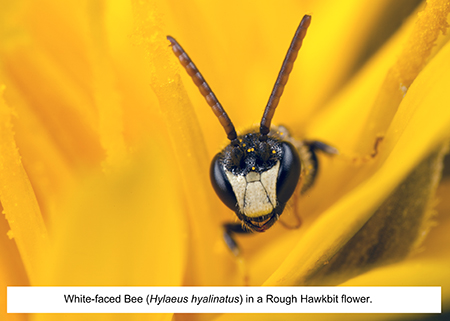
 Most people know about honey bees and bumblebees, but little about solitary bees. We have nearly 30 types of bumblebee in the UK and one honeybee, but well over 200 types of solitary bee.
Most people know about honey bees and bumblebees, but little about solitary bees. We have nearly 30 types of bumblebee in the UK and one honeybee, but well over 200 types of solitary bee.Honeybees and bumblebees are “social” insects in that a queen starts a nest and her female offspring (workers) keep it supplied with food. Solitary bees are different, as the female may make several nests; typically holes in the ground, in old walls or in wood, and will never see her offspring. Once you start looking, you realise that there’s lots of solitary bee activity going on all over the place. I decided in 2011 to record and photograph solitary bees in my garden and in the local churchyard and to learn more about their behaviour. I had the necessary photographic equipment to allow me to take really close-up images of the bees and maximise my chances of properly identifying them. Lots are very hard to identify properly from photographs though, some impossible.
 It did not take me long to find that the house wall was also providing accommodation for other types of bees. I had seen what I thought was a type of all-black bumblebee using holes in the mortar on the stone part of our house wall. These turned out to be female Hairy-Footed Flower Bees (Anthophora plumipes). There were also some mason bees; the Red Mason Bee (Osmia rufa) and the smaller Osmia leaiana using the walls.
It did not take me long to find that the house wall was also providing accommodation for other types of bees. I had seen what I thought was a type of all-black bumblebee using holes in the mortar on the stone part of our house wall. These turned out to be female Hairy-Footed Flower Bees (Anthophora plumipes). There were also some mason bees; the Red Mason Bee (Osmia rufa) and the smaller Osmia leaiana using the walls. Once you start looking at these bees you realise that there are lots of differences from honeybees. Whereas for example, we see honeybees carrying pollen in special pollen “baskets” on their hind legs, some solitary bees have special hairs under their abdomens for this. This can be seen in the picture of the mason bee entering its nest. Many solitary bees though, have "pollen “baskets” on their hind legs, similar to honeybees.
Once you start looking at these bees you realise that there are lots of differences from honeybees. Whereas for example, we see honeybees carrying pollen in special pollen “baskets” on their hind legs, some solitary bees have special hairs under their abdomens for this. This can be seen in the picture of the mason bee entering its nest. Many solitary bees though, have "pollen “baskets” on their hind legs, similar to honeybees. Solitary bees place little piles of pollen and nectar in their nest chambers and lay an egg on each pile. The nest tunnels are divided into individual cells each containing a single egg, together with a food ration. When the tunnel is complete, the entrance is sealed. The eggs hatch and the larvae eat the food left by the parent female. They then spin a cocoon and over-winter in the hole; emerging as adults at various times during the following spring and summer depending on the species and whether their favoured flower type is available. The lifecycle then starts once again. Other types of solitary bees make their nests in the ground, forming little volcano-like piles of soil as they excavate their burrows.
Solitary bees place little piles of pollen and nectar in their nest chambers and lay an egg on each pile. The nest tunnels are divided into individual cells each containing a single egg, together with a food ration. When the tunnel is complete, the entrance is sealed. The eggs hatch and the larvae eat the food left by the parent female. They then spin a cocoon and over-winter in the hole; emerging as adults at various times during the following spring and summer depending on the species and whether their favoured flower type is available. The lifecycle then starts once again. Other types of solitary bees make their nests in the ground, forming little volcano-like piles of soil as they excavate their burrows. The lives of these bees may appear uncomplicated, but it’s not all that it seems. I was surprised when I first read that over a third of solitary bees were parasites of other bees. I had been watching varieties of some common Andrena mining bees and soon spotted some interlopers around their nest burrows. These were Nomada cuckoo bees, looking a bit like wasps. They are known as cleptoparasites because they ‘steal’ the nests of other bees. They wait until the “host” bee is away from the nest and then they lay their eggs inside. When the eggs hatch, the larvae eat the eggs already laid by the resident bee, and the food supply. Because they make no nests of their own, cuckoo bees have no mechanisms for collecting pollen. They do visit flowers though, to feed on nectar.
The lives of these bees may appear uncomplicated, but it’s not all that it seems. I was surprised when I first read that over a third of solitary bees were parasites of other bees. I had been watching varieties of some common Andrena mining bees and soon spotted some interlopers around their nest burrows. These were Nomada cuckoo bees, looking a bit like wasps. They are known as cleptoparasites because they ‘steal’ the nests of other bees. They wait until the “host” bee is away from the nest and then they lay their eggs inside. When the eggs hatch, the larvae eat the eggs already laid by the resident bee, and the food supply. Because they make no nests of their own, cuckoo bees have no mechanisms for collecting pollen. They do visit flowers though, to feed on nectar.I became determined to photograph more of the solitary bees in my area and to get better at recognising the different types and species. Wherever you look, you find more varieties and begin to understand their interesting lifestyles. Some are extremely small and don’t conform to our expectations of what bees should look like. I found several variaties of tiny white-faced bees living in holes in grave stones an the churchyard and feeding on flowers there.
As they spend lots of time visiting flowers, solitary bees are important pollinators and should definitely be encouraged into the garden. There are lots of “bee hotels” available in garden centres and plenty of information around on making your own.
Encouraging solitary bees is also a child-friendly activity, because solitary bees rarely sting and even if they do, their sting is very weak. It looks like there’s increasing interest in encouraging garden wildlife these days. Lots of people feed their garden birds and have an understanding of the importance of insect-friendly planting and the need to maintain “wild” areas in their gardens where possible. Providing habitats for solitary bees is an important part of that process and for some, has become an absorbing hobby too!
